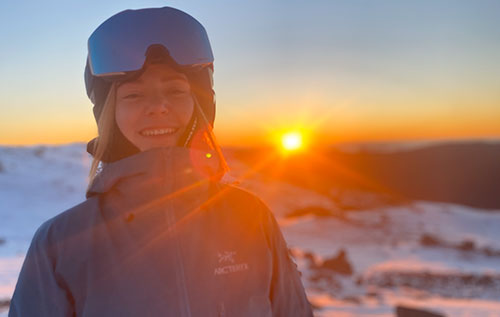How to Choose Thermal Tops for Snow | Buying Guide
If you've ever found yourself shivering halfway through a day on the mountain or sweating buckets under your jacket, then you know how crucial getting your base layer right is. We've been helping Aussie snow enthusiasts gear up since 1985, and a good thermal top is honestly one of the most important pieces in your kit.
What Are Thermals & Why Do They Matter
Thermals are the first layer you wear, sitting closest to your skin and forming the foundation for the rest of your gear. They're generally made from wool, synthetic, or blended fibres that can trap the heat your body produces. But here's the key: they also pull moisture or sweat away from your skin, keeping you dry.
Staying dry = staying warm. That's the golden rule.
If you've ever worn cotton under your gear and ended up freezing halfway through the day, that's because cotton holds onto moisture, leaving you feeling damp and chilly. Thermals are a snug, lightweight layer that can help keep you warmer without adding extra bulk.
Modern thermal tops aren't your grandpa's long johns anymore. They look good enough to wear on their own around the resort.
Materials: What Works Best?
Wool (Our Pick)
Wool blends are very warm, breathable, and naturally odour-resistant, great for multi-day trips or anyone who wants something that won't stink after one wear. Yeah, they cost more upfront, but they'll outlast synthetic options by miles. And don't worry about the "itchy" thing, modern merino wool thermals are incredibly soft.
Synthetic
Synthetic materials are more affordable, dry quickly, and work well if you're on a budget or know you'll be sweating heaps (like spring touring days). Downside? They get pretty smelly and need washing almost every time.
Blends
Blended materials combine the best of both worlds: natural warmth and odour control from wool, plus the durability of synthetics.
Thermal Weight: Light, Mid, or Heavy?
-
Lightweight: Super thin and breathable. Perfect if you're active, run hot, or it's warmer conditions. If I'm going touring or doing laps in spring, I go for lightweight.
-
Midweight (200gm): The sweet spot for most people. Great balance of warmth and breathability, perfect for Aussie conditions and versatile enough for overseas trips. If you're unsure, start here.
-
Heavyweight: Thickest and warmest but less breathable. Choose this if you feel the cold easily or you're heading somewhere properly cold. But if I'm having a stormy day at Perisher or heading to Japan, mid or heavy is the go.
Getting the Fit Right
Thermals should be snug but not tight. Think second skin, not compression wear.
Under insulated jackets: Go lighter weight since your jacket's already doing the warming. Your thermal's job is moisture management.
Under shell jackets: Shells offer zero warmth, so your thermals are doing the heavy lifting. Mid to heavyweight is usually better here.
If you run hot, lightweight thermals will often do the trick. Feel the cold? Opt for mid to heavy and maybe add a fleece or puff layer.
What Beginners Get Wrong
Buying a new ski or snowboard setup can start to add up cost-wise, so many people opt to get cheaper, more cost-effective thermals. While we always encourage you to spend within your budget, cheaper thermals often lose out on their breathability and moisture-wicking properties. This means they'll keep you warm, but you may find yourself overheating and sweating. If this sweat isn't wicked away from your skin, you'll find yourself very cold very quickly.
As a beginner, you're exerting a lot of energy and often sweating more than you expect, so you need that breathability to stay comfortable all day.
Our Team's Top Pick!
Le Bent is our go-to. Made from merino wool and bamboo, they're extremely soft and comfortable with great moisture-wicking. I use Le Bent because it doesn't get smelly, and I can wear it for a few days without it getting gross. Perfect when I'm doing back-to-back days on the hill.
Care Tips
Wash on a gentle cycle with wool-safe detergent and avoid the dryer. Air dry flat to keep the shape. Don't wash them too often. Wool is naturally odour-resistant, so you can get a few wears before it needs a wash.
Frequently Asked Questions
What's the warmest thermal material?
Heavyweight merino wool or wool blends are your best bet. They offer the best warmth-to-weight ratio while still being breathable.
Should I wear thermals under an insulated jacket?
Yep, but go lightweight since your jacket's already providing the warmth. Your thermal's main job is managing moisture and keeping you comfortable.
Are merino thermals itchy?
Nope, modern merino is incredibly soft and comfortable. The old scratchy wool days are long gone.
Do thermals need to be tight?
Snug like a second skin, not tight like compression gear. You want them close enough to wick moisture but comfortable enough to move freely all day.
How many thermal tops do I need for a snow trip?
For a weekend trip, one good one will do if you're not sweating heaps. For longer trips or if you're a heavy sweater, pack two so you've got a fresh one while the other's drying.
What's better if I sweat a lot — wool or synthetic?
Synthetic dries quicker if you're washing daily, but wool resists stink so you can get multiple wears. If you're doing high-output activities like touring, synthetic might be your mate.
Bottom Line
A good thermal is one of those things you don't realise the value of until you're out there in bad weather. It's a game changer in terms of comfort.
Whether you're gearing up for your first snow trip or you're a seasoned powder hound, getting your base layers right sets you up for success.
Check out our full range of thermal tops and thermal bottoms.
Posted by Rhythm Snowsports on























